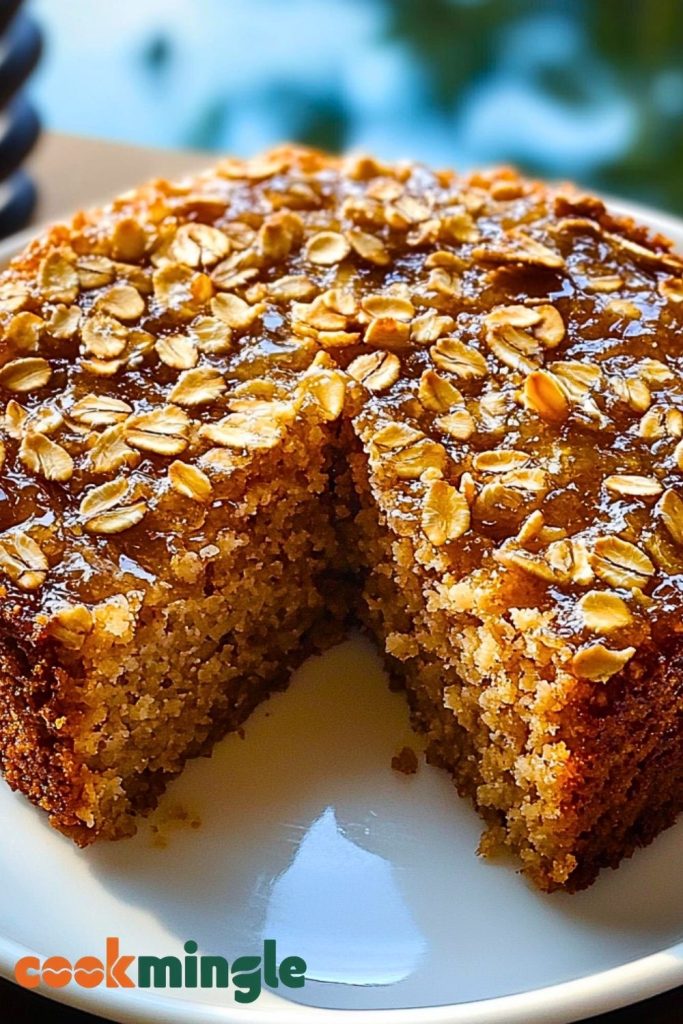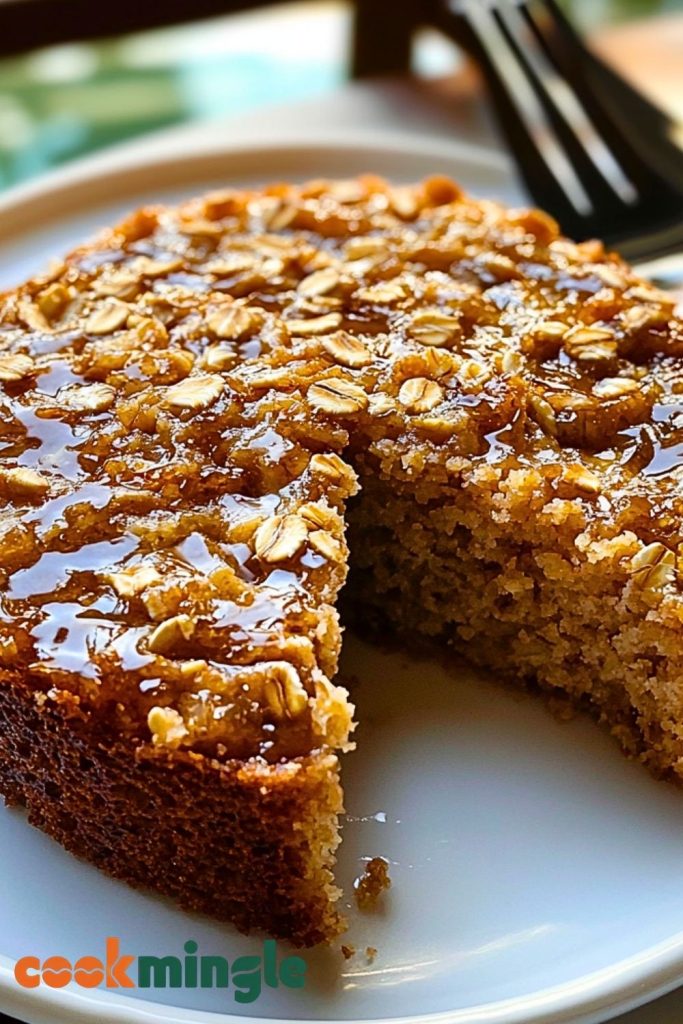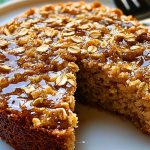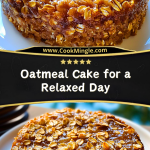There’s something incredibly comforting about a warm slice of oatmeal cake, especially when the day is slow, the coffee is hot, and the to-do list is delightfully empty. I make this oatmeal cake when I want a bit of cozy sweetness without the fuss of frosting, layers, or complicated steps. It’s the kind of cake that reminds me of home—moist, spiced just right, and topped with a buttery, broiled coconut-oat crumble that gives it a slightly crisp, caramelized finish.

What I love most is how humble it is. This isn’t a showy dessert—it’s the kind of cake you eat barefoot in the kitchen, maybe with a second cup of coffee or a glass of cold milk. It makes the perfect breakfast treat or afternoon snack, and I can promise you this: it never lasts more than a day in my house.
Why You’ll Love This Oatmeal Cake
- Incredibly moist texture thanks to the soaked oats.
- Simple ingredients you likely already have in your pantry.
- A nostalgic flavor that brings warmth and comfort.
- Topped with a broiled coconut-oat topping that’s chewy, sweet, and toasty.
- Perfect for breakfast, dessert, or a midday treat.
- No fancy equipment required—just one bowl and a baking dish.
What Kind of Oats Should I Use for Oatmeal Cake?
Old-fashioned rolled oats are your best bet for this cake. They soften beautifully when soaked in hot water, giving the cake a rich, tender crumb without turning mushy. Quick oats will work in a pinch, but you might lose some of that hearty texture that makes this cake so satisfying. Steel-cut oats, on the other hand, are a no-go—they’re too tough and chewy for this particular recipe unless you precook them, which changes the cake entirely.
If you’re like me and enjoy a bit of bite in your cake, stick with the rolled oats. They hold up well, absorb just enough moisture, and create that signature oatmeal cake consistency that’s somewhere between a muffin and a pudding cake.
Options for Substitutions
- Butter: Swap with coconut oil or vegan butter if you’re keeping it dairy-free. Just note that coconut oil will add a mild coconut flavor.
- Brown Sugar: Can’t find brown sugar? Use white sugar mixed with a bit of molasses, or try coconut sugar for a more caramel-like depth.
- Eggs: For an egg-free version, flax eggs (1 tbsp ground flax + 3 tbsp water per egg) will do the trick.
- Milk: Any milk works here—dairy, oat, almond, or soy. Just stick with unsweetened if possible.
- Topping: Not a fan of coconut? Skip it and just use oats, brown sugar, and butter for a simpler crisp topping. Or toss in some chopped pecans or walnuts for extra crunch.
This cake is forgiving, which is one of the reasons I return to it again and again. Make it your own without fear of ruining the whole batch.
Ingredients for This Oatmeal Cake
- Old-Fashioned Rolled Oats
These are soaked in hot water to soften them, which gives the cake its signature moist texture and comforting chew. - Boiling Water
Used to soak the oats—this step helps hydrate them and begin breaking them down before baking. - Brown Sugar
Adds rich sweetness and moisture to the cake, with a hint of molasses flavor. - Granulated Sugar
Balances the deeper flavor of brown sugar with a lighter sweetness. - Butter
Melted butter adds richness and a tender crumb to the cake. It’s also used in the topping for a golden, toasty finish. - Eggs
They bind the cake together and provide structure while keeping everything soft. - All-Purpose Flour
Gives the cake its body and helps hold everything together without making it too dense. - Baking Soda
This leavening agent helps the cake rise and stay fluffy, even with the weight of the soaked oats. - Cinnamon & Vanilla Extract
Together, they bring warmth and depth—cinnamon for a cozy spice, and vanilla for that sweet, homey aroma. - Salt
Just a pinch enhances the overall flavor and balances the sweetness. - Shredded Sweetened Coconut
Goes in the topping to add chewiness and a toasty edge once broiled. - More Brown Sugar & Butter (for the topping)
When melted and broiled with the oats and coconut, they form a caramelized, irresistible crust. - Milk (for the topping)
Helps create a creamy, pourable topping that bubbles up into golden perfection under the broiler.

Step 1: Soak the Oats
In a medium bowl, pour boiling water over the rolled oats. Let them sit and absorb the water for about 20 minutes. This softens the oats and creates the moist foundation for the cake.
Step 2: Preheat the Oven and Prepare the Pan
While the oats are soaking, preheat your oven to 350°F (175°C). Grease a 9×13-inch baking dish or line it with parchment paper.
Step 3: Mix the Wet Ingredients
In a large bowl, whisk together the melted butter, brown sugar, granulated sugar, and vanilla extract. Add the eggs one at a time, beating well after each addition until the mixture is smooth and glossy.
Step 4: Combine Oats with the Wet Mixture
Once the oats have fully absorbed the water, stir them into the sugar-butter-egg mixture. The oats should be warm but not hot to avoid scrambling the eggs.
Step 5: Add the Dry Ingredients
Sift in the flour, baking soda, cinnamon, and salt. Mix gently until everything is well incorporated, but don’t overmix—you want a tender cake, not a tough one.
Step 6: Bake the Cake
Pour the batter into your prepared baking dish and spread it out evenly. Bake for 30–35 minutes, or until the top is golden brown and a toothpick inserted into the center comes out clean.
Step 7: Prepare the Topping
While the cake is baking, mix the shredded coconut, oats, brown sugar, melted butter, and milk in a small bowl. Set it aside so the flavors can meld.
Step 8: Add the Topping and Broil
Once the cake is done baking, remove it from the oven. Immediately spread the topping over the hot cake. Return the cake to the oven and broil for 2–3 minutes until the topping is bubbling and golden brown. Watch carefully to avoid burning.
How Long to Cook the Oatmeal Cake
The base of the cake should be baked at 350°F (175°C) for 30 to 35 minutes, depending on your oven. You’ll know it’s ready when the edges start pulling slightly from the pan and a toothpick inserted into the center comes out clean (with maybe just a few moist crumbs).
After the cake is baked, you’ll add the topping and broil for 2 to 3 minutes until the top is bubbling and golden. Keep a close eye on it—broilers work fast and can go from golden to burnt in seconds.
Tips for Perfect Oatmeal Cake
- Let the oats fully soak. Don’t rush this step—20 minutes of soaking is crucial for texture and moisture.
- Use room-temperature eggs so they mix evenly into the batter.
- Don’t overmix once you add the flour; mix just until combined for a soft, tender crumb.
- Use fresh baking soda for the best rise—old leavening agents can result in a flat, dense cake.
- Spread the topping evenly so every bite gets a bit of that golden, toasty finish.
- Watch the broiler closely. Set a timer and don’t walk away—the topping should be bubbly and golden, not burned.
- Cool slightly before serving so the texture sets and the topping holds together nicely.
Watch Out for These Mistakes While Cooking
- Skipping the oat soak: If you don’t soak the oats, the texture will be gritty and undercooked. The soak is what gives this cake its soft, almost pudding-like quality.
- Using steel-cut oats: They’re too hard and won’t soften properly in this recipe, even with soaking. Stick with rolled oats.
- Overmixing the batter: This can lead to a dense, chewy cake. Mix just until everything is incorporated.
- Underbaking the base: If the cake isn’t fully baked before adding the topping, it may sink or turn soggy. Check the center with a toothpick first.
- Broiling too long: It only takes a few seconds for the topping to go from golden to burnt. Stay close and keep an eye on it.
- Adding topping to a cool cake: The hot cake helps the topping melt and stick. If the base cools, the topping won’t caramelize properly.
- Using cold ingredients: Cold eggs or butter can cause the batter to seize or bake unevenly. Bring everything to room temp before starting.
What to Serve With Oatmeal Cake?
Hot Coffee or Latte
The warm spices and toasty topping of the cake pair perfectly with a smooth, rich coffee or creamy latte.
Cold Glass of Milk
Classic and refreshing, milk brings out the sweetness and softens the spice just enough.
Scoop of Vanilla Ice Cream
Serve a warm slice with vanilla ice cream for a nostalgic dessert that’s pure comfort.
Fresh Berries
Strawberries, raspberries, or blueberries add brightness and contrast to the rich flavor of the cake.
Drizzle of Warm Maple Syrup
For extra indulgence, drizzle some syrup over the top—especially if serving the cake at breakfast or brunch.
Whipped Cream
A dollop of lightly sweetened whipped cream on top adds a soft, creamy finish that balances the chewy topping.
Warm Spiced Apples
Sauteed apples with a bit of cinnamon and butter make this feel like fall in a bowl.
Herbal Tea
If you’re not a coffee drinker, a soothing cup of chamomile or spiced chai tea is just right.
Storage Instructions
Oatmeal cake stores beautifully, which makes it a great make-ahead treat. Once the cake has cooled completely:
- Room Temperature: Keep it tightly covered or in an airtight container for up to 2 days on the counter. The topping will stay chewy and the crumb moist.
- Refrigerator: Store for up to 5 days in the fridge. Just warm individual slices slightly before serving to bring back that fresh-baked texture.
- Freezer: Yes, it freezes well! Wrap slices individually in plastic wrap, then place in a freezer-safe bag. They’ll keep for up to 2 months. Thaw at room temperature or reheat in the microwave for a cozy treat.
To reheat, microwave for 15–20 seconds or pop into a low oven (around 300°F) for 5–10 minutes until warm.
Estimated Nutrition (per serving – based on 12 servings)
- Calories: ~340
- Total Fat: 15g
- Saturated Fat: 9g
- Unsaturated Fat: 5g
- Cholesterol: 55mg
- Sodium: 180mg
- Carbohydrates: 46g
- Fiber: 2g
- Sugar: 28g
- Protein: 4g
Note: These values are estimates and can vary based on exact ingredients and portion sizes used.
Frequently Asked Questions
How do I know when the oatmeal cake is done baking?
The top should be golden and firm, and a toothpick inserted into the center should come out clean or with a few moist crumbs (but no batter).
Can I make this oatmeal cake ahead of time?
Yes! It actually gets even better the next day. Bake it the night before and reheat slices as needed. The topping stays chewy and the cake stays moist.
Can I leave out the coconut in the topping?
Absolutely. If you’re not a fan of coconut, replace it with more oats or chopped nuts like pecans or walnuts for crunch.
What kind of pan should I use?
A 9×13-inch baking dish is perfect. You can also use a slightly smaller one for a thicker cake—just increase the baking time a bit.
Can I make this cake gluten-free?
Yes! Swap the all-purpose flour for a 1:1 gluten-free baking flour blend, and make sure your oats are certified gluten-free.
Why does my topping burn under the broiler?
It likely stayed under the broiler too long. Broilers vary in intensity, so always watch closely—2 to 3 minutes is usually enough.
Can I add fruit to the cake?
You can! Chopped apples or raisins work well mixed into the batter, but avoid anything too juicy that might affect texture.
Is this cake good for breakfast?
Yes, and it might be the best part of a slow morning. It’s hearty, not too sweet, and pairs beautifully with coffee or tea.
Conclusion
Oatmeal cake is the kind of recipe that feels like a warm hug in food form—simple, cozy, and undeniably satisfying. It doesn’t demand fancy steps or specialty tools, just a bit of patience and a craving for something sweet and nostalgic. Whether you’re making it for breakfast, dessert, or an afternoon pick-me-up, this cake delivers every time.
So go ahead—soak those oats, turn on the oven, and treat yourself to a slice of comfort. You deserve it.

Oatmeal Cake for a Relaxed Day
- Total Time: 55 minutes
- Yield: 12 servings
- Diet: Vegetarian
Description
Craving something cozy, easy, and nostalgic? This oatmeal cake is the ultimate comfort treat. Made with soaked oats, brown sugar, and a broiled coconut-oat topping, it’s moist, tender, and full of old-fashioned charm. Perfect as a quick breakfast, easy dessert, or a sweet addition to your brunch ideas list, this cake is simple to make and impossible to forget. A classic you’ll return to every time you need a warm, feel-good bite.
Ingredients
1 cup old-fashioned rolled oats
1 1/2 cups boiling water
1/2 cup unsalted butter, melted
1 cup brown sugar
1/2 cup granulated sugar
2 large eggs
1 teaspoon vanilla extract
1 cup all-purpose flour
1 teaspoon baking soda
1/2 teaspoon cinnamon
1/4 teaspoon salt
1/2 cup shredded sweetened coconut
1/2 cup rolled oats
1/2 cup brown sugar
1/4 cup butter, melted
2 tablespoons milk
Instructions
1. Pour boiling water over oats in a bowl and let soak for 20 minutes.
2. Preheat oven to 350°F (175°C) and grease a 9×13-inch baking dish.
3. In a large bowl, whisk together melted butter, brown sugar, granulated sugar, and vanilla.
4. Add eggs one at a time, mixing well.
5. Stir soaked oats into the wet mixture.
6. Sift in flour, baking soda, cinnamon, and salt. Mix gently until combined.
7. Pour batter into the prepared dish and spread evenly.
8. Bake for 30–35 minutes or until a toothpick comes out clean.
9. While baking, mix all topping ingredients in a bowl.
10. Once baked, remove the cake from the oven and spread topping over it.
11. Broil for 2–3 minutes until bubbly and golden—watch closely.
12. Let cool slightly before serving for best texture.
Notes
Make sure the oats are fully soaked—this step is key for texture.
Always broil the topping while the cake is still hot.
Let the cake cool slightly before slicing to help it set perfectly.
- Prep Time: 20 minutes
- Cook Time: 35 minutes
- Category: Dessert
- Method: Baking
- Cuisine: American
Nutrition
- Serving Size: 1 slice
- Calories: 340
- Sugar: 28g
- Sodium: 180mg
- Fat: 15g
- Saturated Fat: 9g
- Unsaturated Fat: 5g
- Trans Fat: 0g
- Carbohydrates: 46g
- Fiber: 2g
- Protein: 4g
- Cholesterol: 55mg

